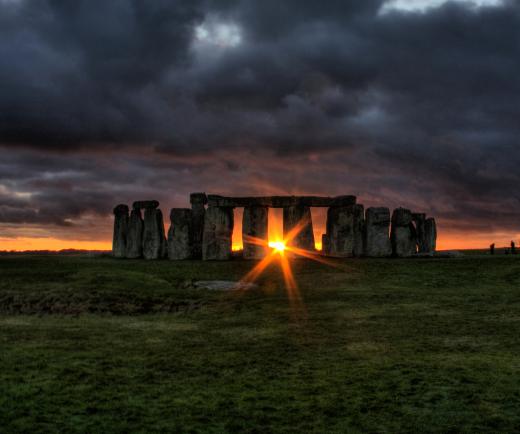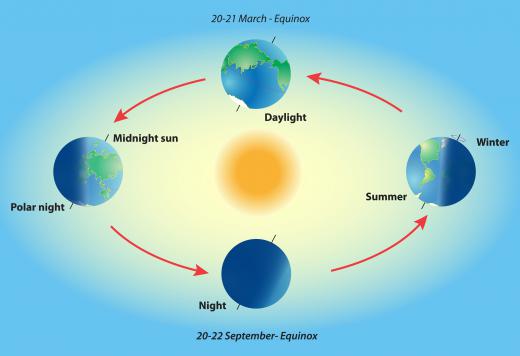What is an Equinox?
 Mary McMahon
Mary McMahon
An equinox is a period in the orbit of a planet in which the planet's orbit and position cause the Sun to pass directly over the equator. In addition to being an astronomy event of note, it also marks a shift in the seasons. On Earth, equinoxes appear around 22 September and 20 March every year, although the days can shift slightly, especially since the date is calculated using Coordinated Universal Time (UTC), which means that equinoxes in the Far East can fall a day or more later than equinoxes in Europe and the Americas, because of time differences.
Every planet has a center line or equator, along with a celestial equator, an imaginary plane created by moving outwards from the equator. When the equinox occurs, the Sun is directly over the celestial equator, which means that someone standing at the equator would be able to see the Sun immediately overhead. It also means that half of the planet is fully illuminated, and that day and night are of roughly equal length.

Given the name, which involves the root for "same," one might be forgiven for thinking that day and night are of equal length at this point in the year; however, this is not actually the case. A number of factors can influence the length of daylight experienced in any given area, and the precisely equal days and nights actually fall slightly ahead of the spring equinox, and just after the fall equinox. Two people standing at equal distance from the equator would experience days and nights of the same length, however.

For people at the North Pole, the spring equinox signals the start of six months of near continuous daylight, while people at the South Pole have six months of night to look forward to, as their fall and winter are just beginning. On this one day in the calendar, however, both see equal amounts of sunlight, even if it signals the start of different seasons.
Another interesting event occurs at this time: the Sun rises due east, and sets due west. Many cultures have associated specific meanings with these times of year. These dates traditionally mark the changes of the seasons, just like the winter and summer solstice, which mark the shortest and longest days of the year respectively. Festivals have often fallen on or around these dates historically, and people may use the event as a handy reminder to perform routine maintenance on homes or cars.
AS FEATURED ON:
AS FEATURED ON:












Discussion Comments
I have to say, even if we could eliminate religious holidays from the world, I wouldn't want to. It is the vast and diverse world of cultural anthropology that keeps humans moving in a forward momentum. We need to embrace our differences and accept them for what they are.
With out the cultural diversity we wouldn't have a beautiful selection of people to appreciate. What about the cultures that already celebrate the equinox? Should we assimilate to their beliefs or run over them in an attempt to claim the event as some new national, non-secular holiday.
@CoffeeJim, this sounds so wonderful, the concept of bringing together waring religions with a calendar date but it is far from reality.
People are so entrenched in their cultural regularities and celebrate crucial dates on the calendar because of historical reference not just astrological ones.
Asking people to give up religious holidays and use equinoxes and solstice events as a means to get by would be ignoring the founding of their faiths. It is a nice thought though, just impractical.
@MrPolitic99, I think you might be onto something here. I mean, the connection to many of the worlds major and minor religions and the solstice and equinox markers on the calendar is too strong to ignore.
Perhaps we could use these secular dates as a way of bridging the cap between these differing and sometimes ferocious cultural beliefs.
Instead of national holidays based on archaic and biased religions, we could combine into a more uniform and generally accepted form of celebration.
I like to use the natural dates of an equinox to celebrate common types of holidays. In today's somewhat secularized world of non-religious association these dates of scientific and meteorological importance are great replacements for sometimes far fetched legacies and traditions.
Instead of Christmas, my family celebrates the Winter solstice which falls on very near dates on the calendar. For Spring equinox we will bring in the warming of the Earth with Easter like celebrations and in the Fall, we celebrate the fall equinox by dressing up in Halloween like costumes.
It is different then many other families but the similarities in not only traditions but in dates can lead some to believe that these significant yearly occurrences have weaved throughout different cultures and belief systems.
Post your comments